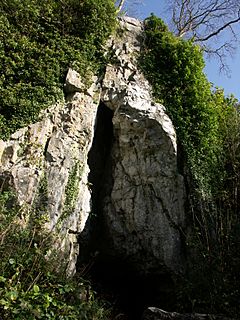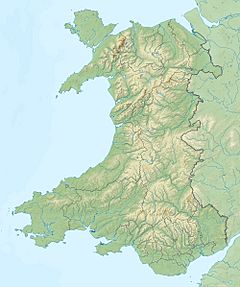Cathole Cave facts for kids

Limestone outcrop
with triangular fissure at the cave |
|
| Location | Parc le Breos Cwm valley, near Swansea |
|---|---|
| Region | Wales |
| Coordinates | 51°35′23.64″N 4°6′44.64″W / 51.5899000°N 4.1124000°W |
| History | |
| Material | Karst |
Cathole Cave, also known as Cat Hole Cave, is an amazing ancient cave in Wales. It is found near Parc Cwm long cairn at Parc le Breos, on the Gower Peninsula. The cave is a steep limestone rock formation. It sits high up in the Parc le Breos Cwm valley, about 45 meters (150 feet) above the valley floor.
The cave has a deep, triangular opening that goes into the hillside. It gets narrower towards the top. There are two entrances, with a natural flat area outside the bigger one. Cathole Cave is about 12 kilometers (7.5 miles) west-southwest of Swansea, Wales.
Contents
Discovering Cathole Cave
People have used Cathole Cave for thousands of years. It was a shelter for groups of ancient hunters during the Mesolithic period. Later, it was used as a burial place during the Neolithic period.
Early Digs and Finds
The first time archaeologists dug in the cave was in 1864. They found items from the Mesolithic period all the way up to the Middle Ages.
In 1959, archaeologist Charles McBurney wrote that the cave was often used by Mesolithic hunters. This idea was confirmed by another archaeologist, John Campbell, who dug there in 1977.
Oldest Discoveries
In 1984, another excavation by Aldhouse-Green found even older items. These included two pointed tools called tanged points. They might be from around 28,000 years ago. This was during a warmer time in the Ice Age, called an interglacial period.
These tools are from roughly the same time as the famous Red Lady of Paviland. The "Red Lady" was found in a cave about 13 kilometers (8 miles) west of Cathole Cave. She is the oldest known human burial in Great Britain, dating back about 29,000 years.
Ancient Art and Tools
Cathole Cave is special because of the ancient art found inside. It also holds clues about the tools people used long ago.
Oldest Rock Art
In September 2010, something incredible was found on the back wall of Cathole Cave. It was Rock art from the Upper Paleolithic period. This engraving, which is about 15 by 11 centimeters (6 by 4.3 inches), is thought to show a reindeer.
Scientists used radiocarbon dating to find out its age. It is about 14,505 years old. Dr. George Nash, the archaeologist who found it, said it is "the oldest rock art in the British Isles, if not north-western Europe."
After this discovery, the cave was scanned using special laser technology. To protect the cave from damage, a metal gate was put at the entrance. Even with the gate, Dr. Nash has found other possible ancient marks inside the cave.
Stone Age Tools
Tools from the Late Glacial period, around 12,000 years ago, have also been found. These are stone tools from the Upper Palaeolithic time. They include:
- flint blades called Cheddar points
- Smaller blades known as Cresswell points
- Scrapers
- Burins or lithic flakes (sharp pieces of stone)
- Flint and bone awls (tools for making holes)
- A bone needle
Flint is not common in Wales. So, these flint tools must have been brought to Gower from other places. These places could be what is now southern or eastern England, or Antrim in Northern Ireland. They might have been brought as finished tools or as raw pieces of flint.
Animal Clues
At the same level as the Upper Palaeolithic tools, archaeologists found bones of ancient animals. These included:
- red fox
- Arctic fox
- brown bear
- tundra vole
- Possibly reindeer
These animal remains help us understand what the climate was like around 12,000 years ago. Other animal bones found in the 1800s might be even older. These include bones from:
Bronze Age Finds
Several items from the Bronze Age have also been found in Cathole Cave. These include:
- A bronze axe head
- Two human skeletons
- Pieces of pottery from burial urns and other pots



